
MinIO on Single Node Brief
Ampere Workload Brief for Object Storage MinIO on a Single Node
Ampere - Empowering What’s Next
Humans and systems are generating and collecting vast amounts of data every day. From social media posts and videos to sensor data, IoT devices and of course the surge in AI applications, the volume of data is growing exponentially. A significant portion of today’s data is unstructured, such as images, videos, documents, and log files. Object storage excels at handling unstructured data by allowing flexible metadata and seamless scalability. Further, it provides a foundation for data analytics and AI applications, a scalable and cost-effective solution to store and manage this massive volume of data. It allows large datasets to be stored in a distributed manner, enabling efficient data processing and analysis. Overall, object storage is important for today’s data-driven organizations because it addresses the challenges of managing massive volumes of unstructured data, ensures data durability and availability, enables advanced analytics, and provides cost-effective storage solutions.
The Ampere® Altra® Family aarch64 processors (32 to 128 cores per socket) are complete system-on-chip (SOC) solutions ideally suited for large-scale, high-performance storage. In addition to incorporating many high-performance cores, Ampere’s innovative architecture delivers predictable high performance, linear scaling, and high energy efficiency. More importantly, the high I/O bandwidth provides direct connections to multiple PCIe devices like SSD drives, which are essential for heavy workload applications.
MinIO Object Storage on Ampere Altra Max Processors
MinIO is fully compatible with Kubernetes, and Docker deployments, and bare metal is fully supported on a swath of operating systems, including most current versions of Linux. Its open-source, software-defined, object storage system is optimized for the private cloud. MinIO is the world's fastest-growing object storage company, with more than 1 billion Docker pulls and more than 46K GitHub Stars.
MinIO offers a host of enterprise features including inline erasure coding, bit-rot detection, state-of-the-art encryption, active-active replication, object locking, lifecycle management, and identity + access management.
Typical MinIO use cases
- Data backups
- Application data caching
- Image thumbnails
- Sensor data / IoT
- Transaction logs
- Metadata storage
- CDN caching
Ampere® Altra® Family Processors Deliver Disruptive Value for Large-Scale, High-Performance Storage Solutions
- Higher core countsas compared to competitors.
- Predictable and linear workload performance.
- Leading energy efficiency reduces power costs and carbon footprint.
- High I/O bandwidth: 128 lanes PCIe Gen4 which are essential for high-performance storage solutions.
In this brief around MinIO SDS, Ampere®, MinIO, Supermicro and Samsung collaborate to showcase MinIO performance data after running tests with an Ampere Altra Max and with Intel Xeon Gold 6330 processor on a single node under 100Gbps network bandwidth.
MinIO SDS Architecture
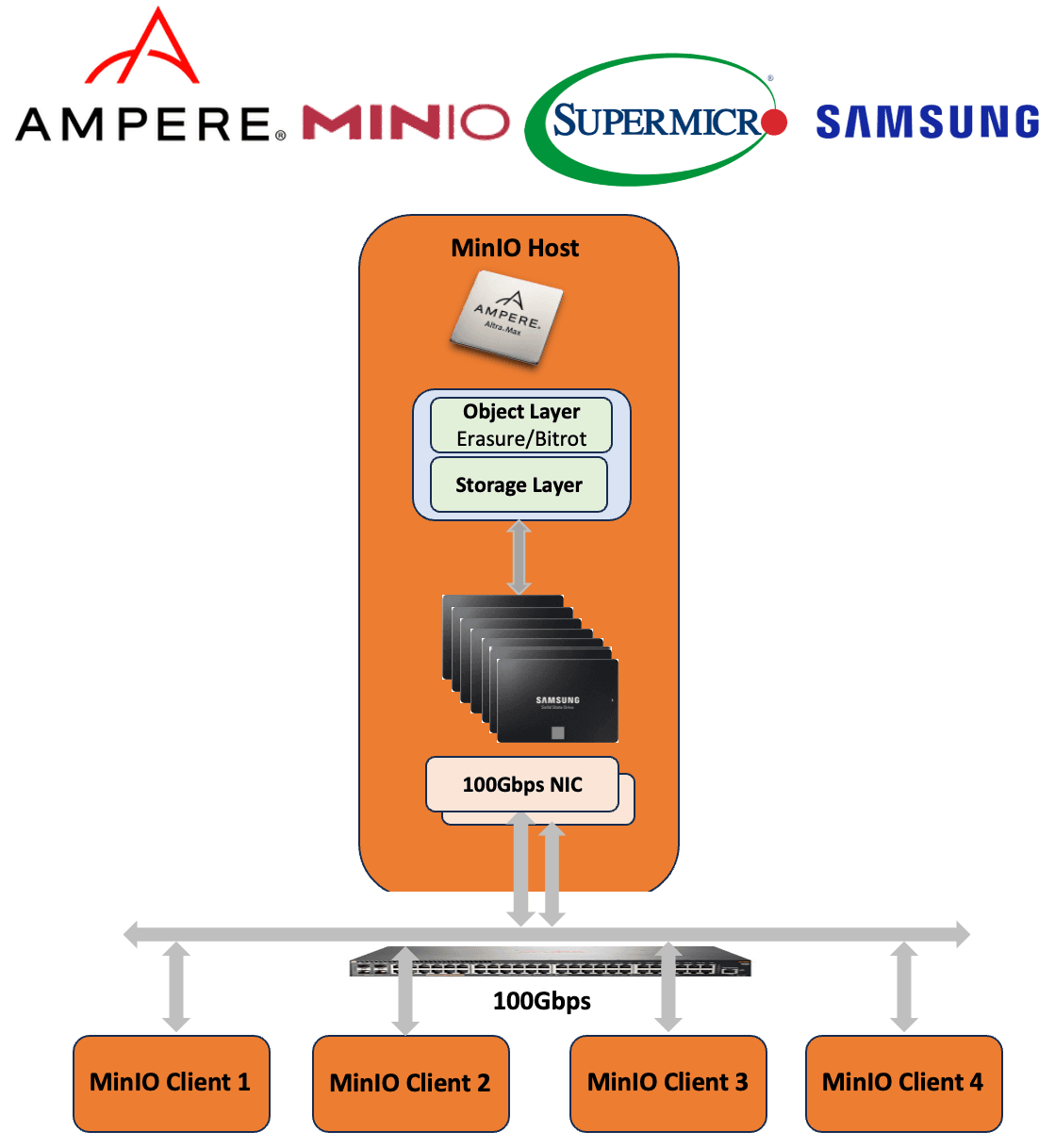
Benchmarking Configuration
| Ampere MinIO Host | Intel MinIO Host | |
|---|---|---|
| CPU Type | 1 x Ampere Altra Max 128 Arm v8.2+ 64-bit CPU cores up to 3.0 GHz | 2x Intel(R) Xeon(R) Gold 6330 CPU |
| Memory | 256GB DDR4-3200 Memory | 256GB DDR4-3200 Memory |
| Storage | 2x 100Gbps ConnectX-5/6 NICs | 2x 100Gbps ConnectX-5/6 NICs |
| MinIO SDS |
- MinIO version RELEASE.2023-06-23T20-26-00Z - Runtime: go1.19.10 linux/arm64 |
- MinIO version RELEASE.2023-06-23T20-26-00Z - Runtime: go1.19.10 linux/amd64 |
Supermicro’s server platform paired with Ampere® Altra® Family processors leverages a single unified single socket motherboard design and supports up to 4TB of DDR4 memory for maximum I/O PCIe and storage. Multiple chassis configurations allow customers to configure the platforms to meet their space, power, performance, and I/O requirements.

Benchmarking Configuration and Performances
The setup consists of a single MinIO host and four MinIO clients in which we use to collect MinIO benchmark data for various test modes. For each test mode, we collect data for a variety of object sizes, from a small (around 4k) to much bigger object size of 128M. To perform the benchmark study, we use WARP, which is an open-source full-featured S3 performance assessment software built to conduct tests between WARP clients and object storage hosts.
MIXED Mode
MIXED mode is an essential feature available in MinIO that enables efficient handling and management of large objects by breaking them down into smaller chunks for parallel transfer and fault tolerance purposes. MIXED mode benchmark test several operation types at once and is the most comprehensive (in term of operation types that are evaluated). Besides the essential “read” (GET) and “write” (PUT) operations that every storage deployment relies on, MIXED mode also includes stress tests for operation types like DELETE, RETENTION or MULTIPART. The benchmark will upload --objects objects of size --obj.size and use these objects as a pool for the benchmark.
In MIXED mode, Ampere® Altra® Max delivers up to 23% more performance and 1.5x more efficiency than Intel Ice Lake processors
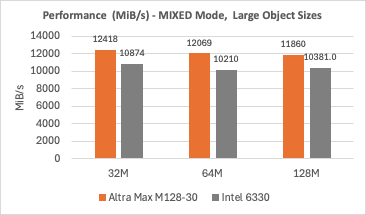
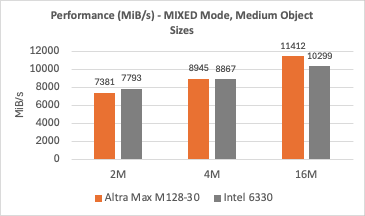
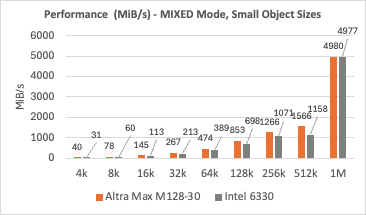
Besides reviewing only total performance (throughput) generated by the CPU, we must evaluate the power draw of the system when undergoing testing. This method provides us a performance per watt metric that encapsulates our performance efficiency.
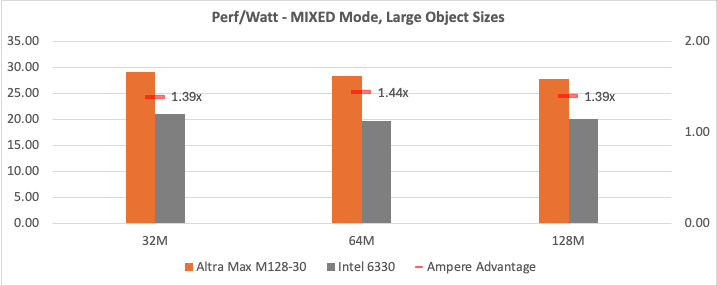
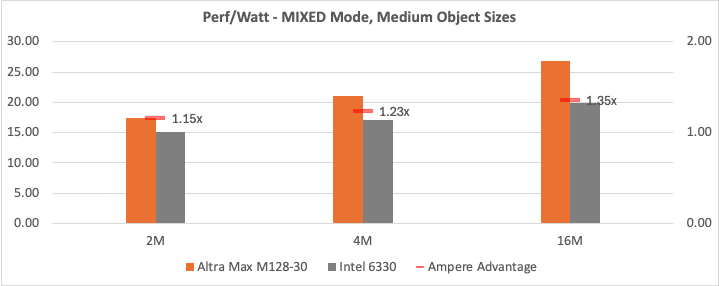
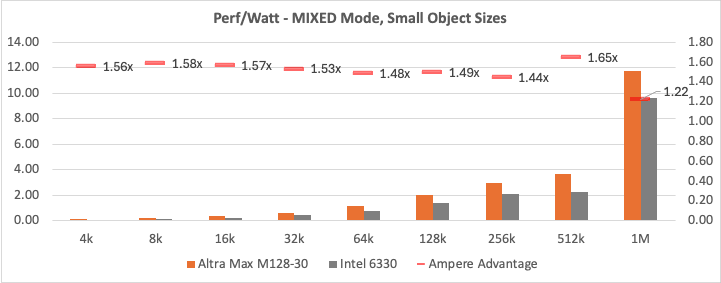
| MIXED Mode | Ampere Altra Max M128-30 (Perf) | Intel Ice Lake 6330 (Perf) | Ampere Altra Max M128-30 (Perf/Watt) | Intel Ice Lake 6330 (Perf/Watt) |
|---|---|---|---|---|
| Small (4k-1M) | 1.23 | 1.00 | 1.5 | 1.00 |
| Medium (2M-16M) | 1.02 | 1.00 | 1.24 | 1.00 |
| Large (32M-128M) | 1.16 | 1.00 | 1.41 | 1.00 |
Note: Figures are averages of various object sizes
GET Mode
GET mode is a fundamental operation supported by most object storage systems and plays an essential role in enabling on-demand access to stored content at scale with minimal latency. It is commonly used when users need to download their files, stream multimedia content or perform various read operations like metadata queries.
In GET mode, Ampere® Altra® Max delivers
- Up to 10% more performance in small object sizes
- 1.5x more efficient than Intel Ice Lake processors
In MinIO, GET mode is a crucial feature that enables efficient and reliable retrieval of existing objects from the storage system for various use cases such as file accessing, streaming media, and data processing applications. Benchmarking GET operations attempt to download as many objects as possible within -duration.
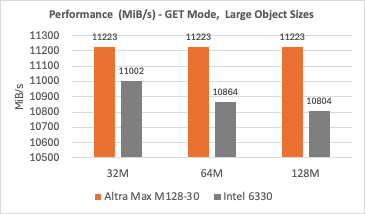
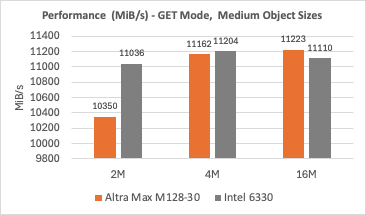
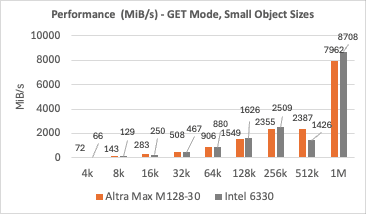
Besides reviewing only total performance (throughput) generated by the CPU, we must evaluate the power draw of the system when undergoing testing. This method provides us a performance per watt metric that encapsulates our performance efficiency.
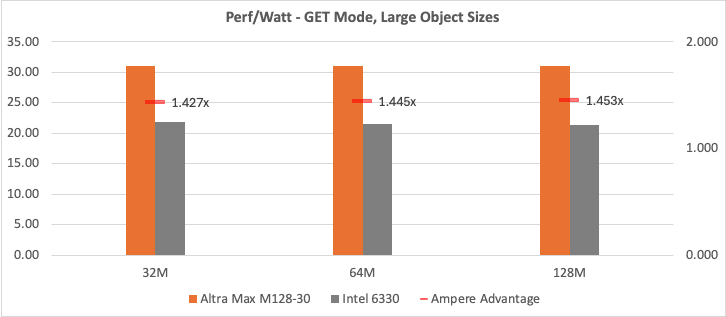
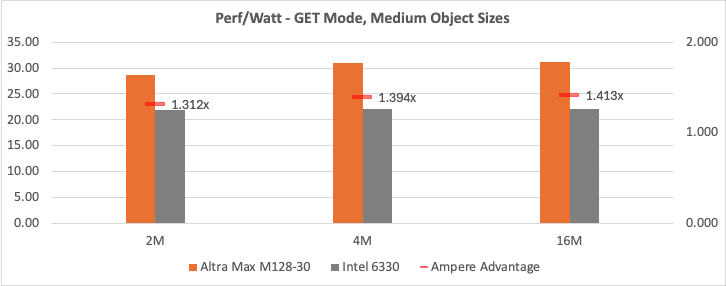
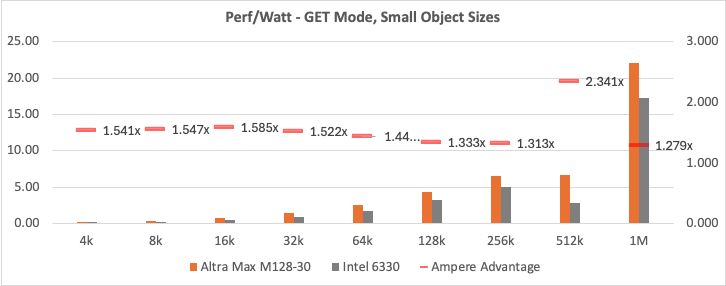
| GET Mode | Ampere Altra Max M128-30 (Perf) | Intel Ice Lake 6330 (Perf) | Ampere Altra Max M128-30 (Perf/Watt) | Intel Ice Lake 6330 (Perf/Watt) |
|---|---|---|---|---|
| Small (4k-1M) | 1.10 | 1.00 | 1.54 | 1.00 |
| Medium (2M-16M) | 0.98 | 1.00 | 1.37 | 1.00 |
| Large (32M-128M) | 1.03** | 1.00 | 1.44** | 1.00 |
Note: Figures are averages of various object sizes **Capped out by maximum 100Gbps network bandwidth
- Interrupt Virtualization
- IO Virtualization
- Enterprise RAS: Memory - SECDED and Symbol Based ECC protected; other memory SECDED ECC protected throughout
- Coherent Mesh Interconnect with distributed snoop filtering
PUT Mode
PUT mode is a fundamental operation supported by most object storage systems that enable users to store new files, manage versions of their contents, or update existing contents efficiently at scale with minimal latency for various use cases such as data ingestion, versioning, and content management applications. Benchmarking PUT operations upload objects of size --obj.size until --duration time has elapsed.
In PUT mode, Ampere® Altra® Max performs well in large object sizes which delivers 1.46x more efficient than Intel Ice Lake 6330
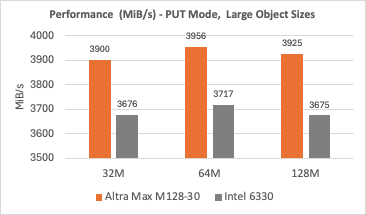
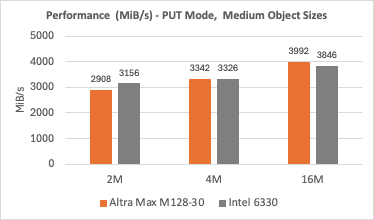
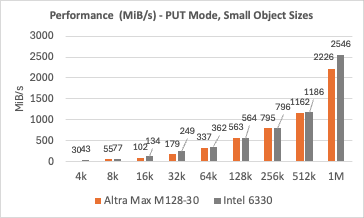
Besides reviewing only total performance (throughput) generated by the CPU, we must evaluate the power draw of the system when undergoing testing. This method provides us a performance per watt metric that encapsulates our performance efficiency.
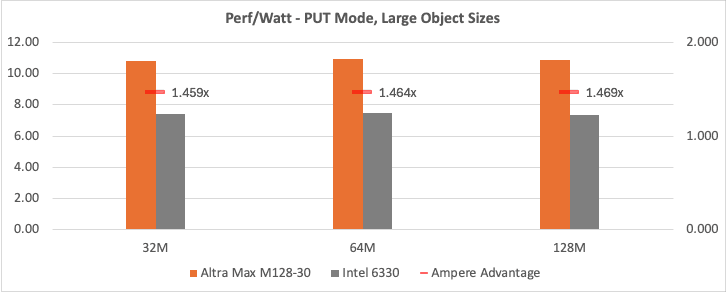
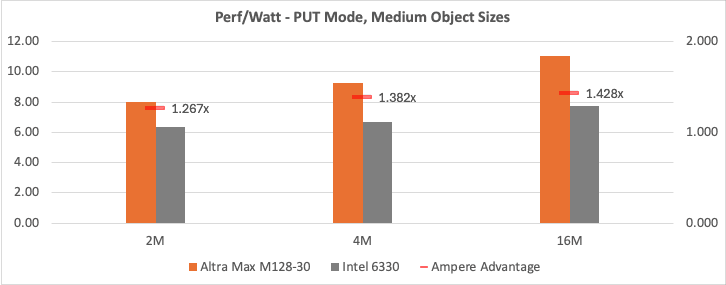
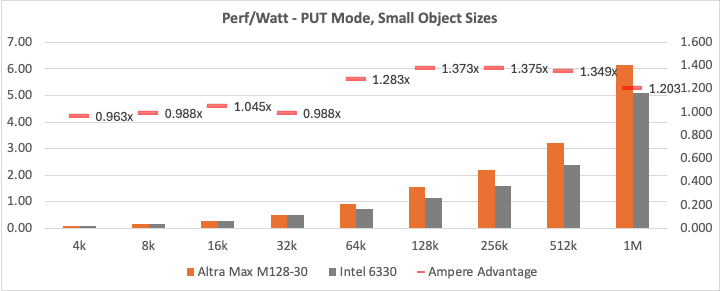
| PUT Mode | Ampere Altra Max M128-30 (Perf) | Intel Ice Lake 6330 (Perf) | Ampere Altra Max M128-30 (Perf/Watt) | Intel Ice Lake 6330 (Perf/Watt) |
|---|---|---|---|---|
| Small (4k-1M) | 0.87 | 1.00 | 1.20 | 1.00 |
| Medium (2M-16M) | 0.99 | 1.00 | 1.36 | 1.00 |
| Large (32M-128M) | 1.06 | 1.00 | 1.46 | 1.00 |
Note: Figures are averages of various object sizes
- Interrupt Virtualization
- IO Virtualization
- Enterprise RAS: Memory - SECDED and Symbol Based ECC protected; other memory SECDED ECC protected throughout
- Coherent Mesh Interconnect with distributed snoop filtering
Benchmarking Results and Conclusions
We ran a series of tests using MinIO SDS to benchmark the highest storage performance on a single Ampere and Intel Ice Lake node . The Supermicro servers using in this brief were each equipped with either one Ampere® Altra® Max processor (128 cores) or two Intel(R) Xeon(R) Gold 6330 CPUs, with eight Samsung MZWLR1T9HCJR-00A07 NVMe SSDs, and two Mellanox ConnectX-5/6 network cards to achieve 100Gbps bandwidth.
Table 4 shows MinIO performance running on Ampere 1P Altra Max M128-30 vs. 2P Intel Ice Lake 6330 platform across various object size from 4k-128M:
| Test Mode | Ampere Altra Max M128-30 (Perf) | Intel Ice Lake 6330 (Perf) | Ampere Altra Max M128-30 (Perf/Watt) | Intel Ice Lake 6330 (Perf/Watt) |
|---|---|---|---|---|
| Mixed | 1.17 | 1.00 | 1.43 | 1.00 |
| Get | 1.06 | 1.00 | 1.49 | 1.00 |
| Put | 0.92 | 1.00 | 1.27 | 1.00 |
Figures are averages of various object sizes: 4k - 128M
MinIO SDS powered by Ampere® can drive sustained peak loads into the drives, delivering industry-leading performance, more efficient, and availability based on a single 2U nodes with eight Samsung NVMe drives and 100Gbps network bandwidth configuration. Consider having higher network bandwidth could result in getting even higher benchmark data.
In the other words, network bandwidth is the bottleneck.
Footnotes
All data and information contained herein is for informational purposes only and Ampere reserves the right to change it without notice. This document may contain technical inaccuracies, omissions and typographical errors, and Ampere is under no obligation to update or correct this information. Ampere makes no representations or warranties of any kind, including but not limited to express or implied guarantees of noninfringement, merchantability, or fitness for a particular purpose, and assumes no liability of any kind. All information is provided “AS IS.” This document is not an offer or a binding commitment by Ampere. Use of the products contemplated herein requires the subsequent negotiation and execution of a definitive agreement or is subject to Ampere’s Terms and Conditions for the Sale of Goods.
Supermicro’s Ampere® platform is a 2U form factor chassis. See efficiency footnotes for details details
System configurations, components, software versions, and testing environments that differ from those used in Ampere’s tests may result in different measurements than those obtained by Ampere.
©2024 Ampere Computing. All Rights Reserved. Ampere, Ampere Computing, Altra and the ‘A’ logo are all registered trademarks or trademarks of Ampere Computing. Arm is a registered trademark of Arm Limited (or its subsidiaries). All other product names used in this publication are for identification purposes only and may be trademarks of their respective companies.
Ampere Computing® / 4655 Great America Parkway, Suite 601 / Santa Clara, CA 95054 / amperecomputing.com
